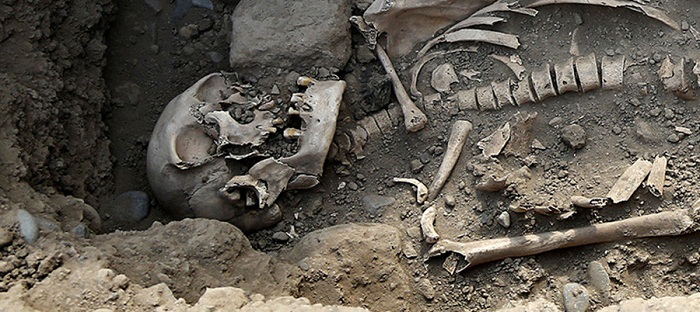Mutilated 6,000 skeletons show Neolithic people maybe not as peaceful as thought

A report of the discovery, published in the December issue of Antiquity, states the deaths likely occurred during a raid or other violent encounter, and that the bodies were piled in a pit which already contained a collection of left arms chopped off by axes or other sharp objects.
It is not clear who the severed arms belonged to. All of the skeletons in the pit have both their arms, except for one skeleton of a male with skull damage caused by violent blows. The skeleton lacks a left arm, though the researchers were unable to determine whether the limb also ended up in the pit.
Chenal and her team are unsure whether the attackers targeted victims` left arms for a reason, but speculate that they could have been taken as war trophies. Scattered hand bones at the bottom of the pit suggest that hands from the severed limbs were deliberately cut into pieces.
Radiocarbon dating of two bones in the pit indicate the men and women walked the Earth about 6,000 years ago. This correlates with what is known about the Neolithic period, during which dead people in farming communities were often disposed of in circular pits.
However, the Bergheim pit provides the first evidence that people killed and mutilated in raids or battles were also buried in circular pits.
“Bergheim is the first discovery which allows [us] to clearly link human deposits in circular pits and violence, probably armed conflicts,” Chenal said, as quoted by Gizmodo. “It’s a very important result, but it raises more questions than it answers.”
Even before the new discovery, the nature of Neolithic burial pits was shrouded in mystery.
Many researchers believe the pits are remnants of storage silos that were later put to other uses, potentially to bury those deemed unworthy of formal burials. Others have argued that they were dug as graves for high-ranking individuals whose servants or relatives were killed to accompany them. Another theory is that slaves might have been killed and put in pits as displays of wealth as sacrifices to gods.
Several objects were also found among the human remains, including a piece of jewelry made from a mussel valve, a stone point, a pig jaw fragment, and two hare skeletons.
The discovery comes three years after 60 circular pits were excavated in Bergheim ahead of a construction project. Thirteen of those contained either skeletons or isolated human bones.















































